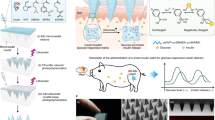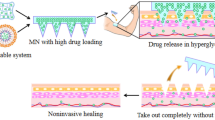Abstract
Two kinds of insulin were loaded into self-dissolving micropile array tip (following tip). Fully-loaded tip (f-tip) and partially-loaded tip (p-tip) were prepared using chondroitin sulfate for the percutaneous administration of insulin. One hundred micropiles were constructed on a 1.0 × 1.0 cm tip. The mean length of the micropile in a tip were 483.4 ± 4.7 μm for the f-tip and 492.6 ± 2.4 μm for the p-tip. The insulin content of the p-tip was 28.5% of that of the f-tip. The pharmacological efficiency of insulin loaded tip was evaluated in rat experiments by measuring their hypoglycemic effects. The maximum hypoglycemic effect of insulin was observed at 1.7 ± 0.2 h for the f-tip and 1.5 ± 0.2 h for the p-tip. Good dose-dependency was observed for the plasma glucose level vs. time curves. These results suggest the usefulness of p-tip as a percutaneous DDS of insulin.






Similar content being viewed by others
References
Henry S, McAllister DV, Allen MG, Prausnitz MR. Microfabricated micropiles: a novel approach to transdermal drug delivery. J Pharm Sci. 1998;87:922–5.
Teo MA, Shearwood C, Ng KC, Lu J, Moochhala S. In vitro and in vivo characterization of MEMS micropiles. Biomed Microdev. 2005;7:47–52.
Park JH, Allen MG, Prausnitz MR. Polymer micropiles for control1ed-release drug delivery. Pharm Res. 2006;23:1008–19.
Davis SP, Martanto W, Allen MG, Prausnitz MR. Hollow metal micropiles for insulin delivery to diabetic rats. IEEE Trams Biomed Eng. 2005;52:909–15.
McAllister DV, Wang PM, Davis SP, Park JH, Canatella PJ, Allen MG, et al. Microfabricated needles for transdermal delivery of macromolecules and nanoparticles: fabrication methods and transport studies. Proc Natl Acad Sci USA. 2003;100:13755–60.
Prausnitz MR. Micropiles for transdermal drug delivery. Adv Drug Deliv Rev. 2004;56:581–7.
Birchall JC. Stratum corneum bypassed or removed. In: Touitou E, Barry BW, editors. Enhancement in drug delivery. New York: CRC Press; 2007. p. 337–51.
Wermeling DP, Banks SL, Hudson DA, Gill HS, Gupta J, Prausnitz MR, et al. Micropiles permit transdermal delivery of a skin-impermeant medication to humans. Proc Natl Acad Sci USA. 2008;105:2058–63.
Kolli CS, Banga AK. Characterization of solid maltose microneedles and their use for transdermal delivery. Pharm Res. 2008;25:104–13.
Ravi S, Khiang PK, Darwis Y, Murthy BK, Rai STR. Development and validation of an HPLC-UV method for the determination of insulin in rat plasma: application to pharmacokinetic study. Chromatography. 2007;66:805–9.
Monteiro-Riviere NA, Bristol DG, Manning TO, Rogers RA, Riviere JE. Interspecies and interregional analysis of the comparative histologic thickness and laser Doppler blood flow measurements at five cutaneous sites in nine species. J Inv Dermatol. 1990;95:582–6.
Bauer J, Bahmer FA, Worl J, Neuhuber W, Schuler G, Fartasch M. A strikingly constant ration exists between Langerhans cells and other epidermal cells in human skin. A stereologic study using the optical dissector method and the confocal laser scanning microscope. J Inv Dermatol. 2001;116:313–8.
Caspers PJ, Lucassen GW, Bruining HA, Puppels GJ. Automated depth-scanning confocal Raman microspectrometer for rapid in vivo determination of water concentration profiles in human skin. J Raman Spectrosc. 2000;31:813–8.
Turncliff RZ, Dunbar JL, Dong Q, Silverman BL, Ehrich EW, Dilzer SC, et al. Pharmacokinetics of long-acting naltrexone in subjects with mild to moderate hepatic impairment. J Clin Pharmacol. 2005;45:1259–67.
Gill HS, Prausnitz MR. Coated micropiles for transdermal delivery. J Control Rel. 2007;117:227–37.
Gill HS, Prausnitz MR. Coating formulations for micropiles. Pharm Res. 2007;24:1369–80.
Cormier M, Johnson B, Ameri M, Nyam K, Libiran L, Zhang D, et al. Transdermal delivery of desmopressin using a coated microneedle array patch system. J Control Rel. 2004;97:503–11.
Acknowledgments
This study was supported by a strategic fund of MEXT (Ministry of Education, Culture, Sports, Science and Technology, MEXT) from 2008 to 2010 for establishing research foundations in Japanese private universities. This study was also partially supported by the Uehara Memorial Foundation.
Author information
Authors and Affiliations
Corresponding author
Rights and permissions
About this article
Cite this article
Ito, Y., Yamazaki, T., Sugioka, N. et al. Self-dissolving micropile array tips for percutaneous administration of insulin. J Mater Sci: Mater Med 21, 835–841 (2010). https://doi.org/10.1007/s10856-009-3923-x
Received:
Accepted:
Published:
Issue Date:
DOI: https://doi.org/10.1007/s10856-009-3923-x




